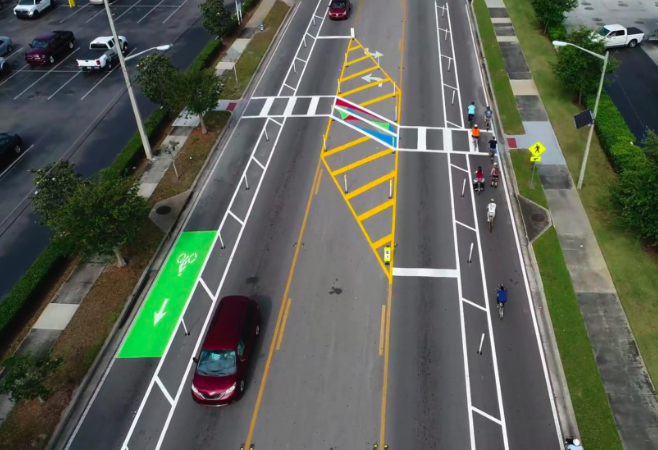No "complete streets" policy will truly be complete until federal agencies dismantle the systems that make it so hard to build safe transportation networks in the first place — but some advocates think that new federal guidance still won't do enough to radically center vulnerable road users in the ways that cities need.
In a sprawling new report to Congress released on Wednesday, the Federal Highway Administration recommitted to making "Complete Streets" design the national default — and, more importantly, revealed insights from state and local agencies about what it would take for the feds to actually help make that vision a reality. Despite the agency's heavy association with controlled-access interstates, almost 70 percent of DOT-funded highways at least occasionally require vulnerable road users to mix with motorists, including tens of thousands of miles of roads running directly through cities and towns.
“A Complete Street is safe, and feels safe, for everyone using the street,” said Deputy Federal Highway Administrator Stephanie Pollack in a statement. “We can’t keep people safe on our roads if we don’t have safer roads and roads that slow down drivers to safe speeds."
Under the recently passed Bipartisan Infrastructure Law, state DOTs will be required to adopt Complete Streets policies of their own, and to spend at least 2.5 percent of their planning funding on projects that make it easier for people of all modes, ages, and abilities to get around. The U.S DOT has also committed to prioritizing safety, equity and sustainability through all its discretionary grant programs, and has issued strong guidelines to states urging them to spend their formula grant programs in similar ways — two actions that advocates believe will lead to the construction of dedicated biking, walking, rolling, and transit infrastructure nationwide.
The term "Complete Streets," though, is not without controversy in the sustainable transportation community, as evidenced by advocates' reaction to the graphic the agency chose to illustrate the new report.
That illustration featured a four-lane, car-dominated highway outfitted with at-grade bike lanes with no vertical buffer, standard-width sidewalks, and high-intensity activated crosswalk beacons. Those elements, of course, do make roads safer — but they they don't fundamentally change the roadway hierarchy, particularly for wheelchair users or slower walkers who might struggle to cross such wide roads in time.
"Well, @SecretaryPete & @USDOT, we know you're trying to help, but this depicted street would be "complete"-ly terrible for safety, economic development, community, everything," tweeted urban planner Victor Brandon Dover. "Very poor illustration."
A Twitter user named @thesurlybiker added, "Tons of replies here explaining why this graphical stroad is not a 'complete street' and far from what needs to be done. Will @USDOTFHWA & @USDOT A) actually pay attention? Or B) is this just another post by a social media manager with no actual public interaction? I vote B."
Since the term was first coined in 2003, the Complete Streets philosophy has faced criticism from some advocates who argue that sustainable transportation should be the fundamental purpose of city roads, not a late-stage effort to "complete" an existing thoroughfare while maintaining (often ample) space for drivers. Others say the approach sometimes over-emphasizes expensive, time-consuming infrastructure interventions to protect vulnerable road users, when simpler and cheaper strategies, like simply slowing down motorists, would save lives much faster.
"In a universe where funding for grade-separated bike lanes alongside bioswales rains down from the sky, 'Complete Streets or bust' would be a reasonable viewpoint," wrote advocate Alex Baca in a 2018 op-ed for Strong Towns. "But our municipalities are increasingly asked to do more with less; in addition, sometimes roads are so needlessly unpleasant and needlessly unsafe that something should be done immediately, rather than waiting for the lengthy planning process that Complete Streets typically require."
Sadly, that debate overshadowed the actual text of the new federal report, which examined the significant structural barriers U.S. communities face when they seek to build any form of vulnerable road user safety improvement — and what must be done to dismantle them.
Those include:
- A serious lack of federal data collection standards on many aspects of active and shared transportation, which leaves leaders in the dark about where basic safety infrastructure like sidewalks even are, what state of repair they're in, how many people are safely using them to walk roll over time, or even what happens when people are struck by motorists — and how those indicators change when improvements are made
- An absence of requirements to analyze the safety impacts of federally-funded projects specifically for vulnerable road users, apart from the Highway Safety Improvement Program, which constitutes just 6 percent of federal funding (and which, historically, hasn't held states accountable for failing to save lives)
- Autocentric federal design guides that fail to protect people with disabilities and other vulnerable populations, and that aren't updated nearly often enough to keep pace with new safety innovations in the field
- Conflict between some state, regional, and city transportation authorities over the importance of Complete Streets over other agency goals, like driver speed, and a lack of training for the skeptical and resistant
- Vague federal definitions of what "sufficient consideration of bicycles and pedestrians" even means in practice, and a lack of technical support on how to achieve it
The agency implied it would tackle many of those barriers internally in the years to come, though some reforms will need to be rubber-stamped by Congress, and others will take several administrations to unwind.
In the meantime, though, U.S. DOT has at least sparked a conversation about the complexities of building safe streets — if not exactly in the way it probably intended.





